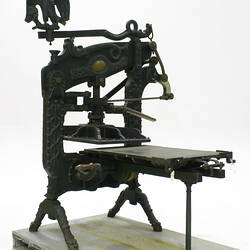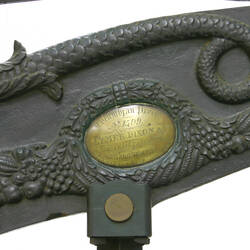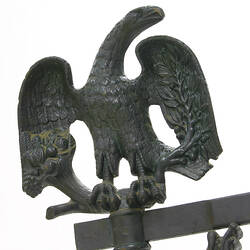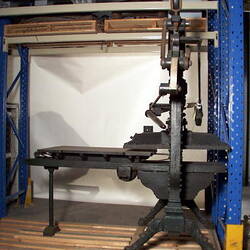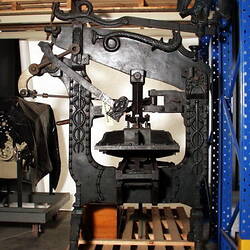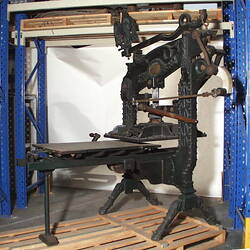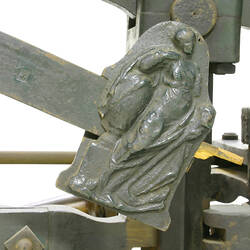Summary
The Columbian Press is an Iron Standing Press, built by Clymer Dixon and Co. of 10 Finsbury Street, London England in 1851.
The Press was donated by T. B. McDiarmid & Sons. The company was established in 1905 by Thomas Bartlett McDiarmid and his brother Jack. They were joined by another brother, William, in 1913. The business specialised in stereotyping and electrotyping. Their acquisition of the Columbian Press is not recorded.
Operation:
A forme was placed on the iron bed of the press and inked by roller or ink ball; a sheet of paper was placed on the open tympan; the frisket was closed down over the tympan to hold the paper in place and the whole folded down over the type forme, resting slightly above the inked type. The bed was then wound under the platen by a handle attached to a central rounce under the bed, the handle pulled forward brought the platen down and an impression was taken. The handle was pushed back and impression lifted and the bed wound back out, where the tympan was lifted off, frisket was lifted off the tympan and the printed sheet removed.
Physical Description
Hand printing press of heavy construction with ornate cast iron columns surmounted by cast eagle. Elaborately moulded serpents and fish decorations.
Significance
The Columbian Press was invented by George Clymer in America, and the first press was released around 1813, but found a limited market. He moved to London in 1817 and began to manufacture presses by the end of 1818, at No. 1 Finsbury Street. Clymer manufactured on his own for nearly twelve years, but took a partner, Samuel Dixon, in 1830. At the end of that year the firm, Clymer and Dixon moved to 10 Finsbury Street. Clymer died in 1834 and Dixon continued the business alone until 1845 when he brought in partners and traded as Clymer, Dixon & Co. In 1851 the firm exhibited press No. 1479, with a platen size 17" x 24", at the International Exhibition in London. At the end of 1851 the firm was taken over by William Carpenter.
The Columbian Press has a significant place in the evolution of printing. Using a beam and counterweight for leverage, its combination of levers acting on a fulcrum, required less exertion on the part of the pressmen working a wood common press although its operation was slightly slower than the Stanhope, or later, the Albion.
Historical Relevance to Melbourne, Victoria:
A Columbian Press was used to print the Port Phillip Gazette in January 1840. It was the second iron press used in Melbourne. The first, a Stanhope, having arrived to print the Port Phillip Herald a few weeks earlier. The Columbian Press was widely used in colonial Victoria. Six of different sizes were ordered in 1851 for the newly established Government Printing Office. It was, however, heavy and cumbersome to transport. Its popularity waned with the introduction of the Hopkinson & Cope Albion. The Columbian Press in the MV collection press represents the technology that grew Melbourne. Most of the State's early printed documents and records were produced on similar Columbians at the Government Printing Office from 1851 onwards. There is no evidence to suggest that the MV Columbian is not a Double Crown press bought by Government in 1851.
More Information
-
Collecting Areas
-
Acquisition Information
Cultural Gifts Donation from T.B. Mcdiarmid & Sons (Vic) Pty Ltd, by Sep 1989
-
Manufacturer
Clymer Dixon & Co, 10 Finsbury Street, London, England, Great Britain, 1851
-
Printer
Mr Peter Marsh, Melbourne, Greater Melbourne, Victoria, Australia, 18 Jun 2007
Peter Marsh is a Research Associate, who has been data enhancing the printing collection. He has supplied information for this record. -
Inscriptions
Oval Brass Plaque on front: Columbian Press No. 1509 Clymer Dixon & Co Original Patentees Manufacturers 10 Finsbury St. 1851 London
-
Classification
-
Category
-
Discipline
-
Type of item
-
Overall Dimensions
1820 mm (Length), 1600 mm (Width), 2200 mm (Height), 1.5 tonnes (Weight)
Peter Marsh states: On standing presses bed and platen sizes are misleading as to the descriptive historical sizes used for presses and it is important to understand that different interpretations exist. Some historians use the platen size as press size. The platen of a press was the maximum area in which pressure could be placed on a type forme. The historical size of a standing iron press sh
-
Other Dimensions
970 mm (Length), 670 mm (Width)
Feed bed 212 cm, height 235 cm.
-
Other Dimensions
870 mm (Length), 580 mm (Width), 25 mm (Depth)
Platen dimensions
-
Keywords


